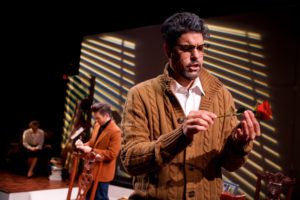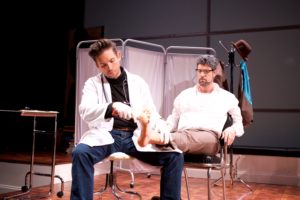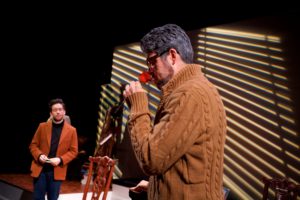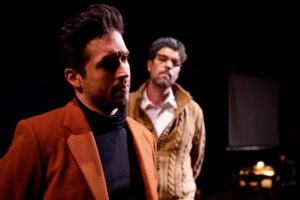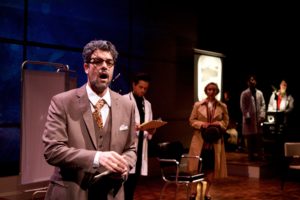Based on the famous novella by Oliver Sacks
Music by Michael Nyman
Libretto by Oliver Sacks, Christopher Rawlence and Michael Morris
“To be sure, Oliver Sacks’ examination of the wonders of neurology are the intellectual design of this opera. But, at its heart, is the human drama of those discoveries. UrbanArias’ production of The Man Who Mistook His Wife For A Hat brings that human drama into clear focus, with beautiful effect.” – Robert Michael Oliver, DCMetroTheaterArts
Click here to read the full review
“. . . intimacy has always been a hallmark of this company. The excellent cast (the patient, his wife and the doctor) does its best to interact with the 180 degrees of audience, and the hour-long piece goes by quickly.” – Robert Battey, The Washington Post
Click here to read the full review
“Nyman’s complex score was played masterfully by Inscape Chamber Orchestra under the direction of UrbanArias founder Robert Wood . . . Mrs. P was played by the incredible Emily Pulley whose strong soprano moved the show along with grace and earnestness.” – Elle Marie Sullivan, MD Theatre Guide
SYNOPSIS
An intimate gaze into the world of a man, Dr. P., with visual agnosia (or “mental blindness” due to damage of visual processing in the brain). These patients see but do not perceive. They see colors, lines, boundaries, simple shapes, patterns, movement – but they are unable to recognize, or necessarily make sense of what they see. They cannot recognize people or places or common objects; their visual world is no longer meaningful or familiar, but strange, abstract, chaotic, mystifying.
If a world cannot be organized visually, patients may adapt calling on other means to give sense to their surroundings. In the case of Dr. P., a talented singer, his exceptional musical ability allows him, in large measure, to return sense to the world by defining it through music. Dr. and Mrs. P. arrive at the neurology clinic of Dr. S., having been referred by an ophthalmologist. A series of routine neurological tests is carried out, revealing little. As he prepares to depart, Dr. P. makes several alarming mistakes and Dr. S. resolves to see him again.
Dr. S. visits Dr. and Mrs. P. in their home to observe his patient in his own environment. The diagnosis continues as the neurologist engages Dr. P. in a variety of visual exercises designed to reveal the nature of Dr. P.’s condition: geometric solids/cartoons/television/ photographs/rose/glove/chess game/visual recall. Dr. S. discovers that Dr. P. is a talented amateur painter. Upon examining a portfolio of his paintings, he concludes that Dr. P.’s illness is reflected in these works, which move from representational to purely abstract. This conclusion angers Mrs. P., who is insistent that the change in her husband’s painting style is an expression of his artistic development, not of his deepening illness. As Dr. P. continues enjoying his tea, Mrs. P explains to the neurologist how her husband manages, through music, to cope with daily life in spite of his perceptual problems. Dr. S. can make no definitive conclusion, but does provide insight through his observation of Dr. and Mrs. P.
Composer Michael Nyman is the notable composer of the film scores The Piano, Gattaca, and The Cook, the Thief, His Wife, and Her Lover. The opera is both minimalist and lyrical in style, with Dichterliebe quotes for Schumann fans.
STARRING
Jeffrey Beruan as Dr. P
Emily Pulley as Mrs. P
Ian McEuen as Dr. S
Conducted by Robert Wood
Directed by Grant Preisser
Set and Costume Design by Grant Preisser
Lighting Design by Jeff Bruckerhoff
LIBRETTO
Click HERE to read the libretto of THE MAN WHO MISTOOK HIS WIFE FOR A HAT




